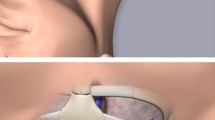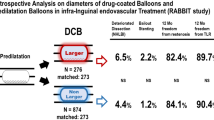Abstract
Background
Although tunneled cuffed catheters (TCCs) are widely used in hemodialysis, little is known about their complications in elderly patients with hemodialysis. Furthermore, there is no report about which vessel access, either jugular or iliac vein, is superior for elderly patients requiring TCCs.
Methods
In the present study, we reviewed the clinical parameters of 127 patients aged over 65 years with 207 new TCC placements and measured the incidence of catheter patency, infection, dysfunction, and survival of TCCs.
Results
We found that the average primary catheter patency was substantially shorter in iliac vein TCCs than in internal jugular vein TCCs (373 vs. 641 catheter-days). Patients with iliac vein TCCs underwent more frequent exchanges than those with internal jugular vein TCCs. Infection-free survival was similar for both groups (p = 0.748), but dysfunction-free survival was significantly poorer in iliac vein TCC group than that in internal jugular vein TCC group (p = 0.001). Age and previous catheter placement were the independent risk factors for TCCs survival.
Conclusion
Taken together, our results suggested that iliac vein TCCs present an increased risk of dysfunction compared to internal jugular vein TCCs in elderly hemodialysis patients.




Similar content being viewed by others
References
Zuo L, Wang M (2010) Current burden and probable increasing incidence of ESRD in China. Clin Nephrol 74(S1):S20–S22
Latos DL (2002) Hemodialysis in the elderly: vascular access and initiation of renal replacement therapy. Semin Dial 15:91–93
Dhingra RK, Young EW, Hulbert-Shearon TE et al (2001) Type of vascular access and mortality in U.S. hemodialysis patients. Kidney Int 60:1443–1451
Allon M, Daugirdas J, Depner TA et al (2006) Effect of change in vascular access on patient mortality in hemodialysis patients. Am J Kidney Dis 47:469–477
Quarello F, Forneris G, Borca M et al (2006) Do central venous catheters have advantages over arteriovenous fistulas or grafts? J Nephrol 19(3):265–279
U.S. Renal Data System (2010) USRDS 2010 annual data report: atlas of end-stage renal disease in the United States. National Institutes of Health, National Institute of Diabetes and Digestive and Kidney Disease, Bethesda, MD
Krishnasami Z, Carlton D, Bimbo L et al (2002) Management of hemodialysis catheter related bacteremia with an adjunctive antibiotic lock solution. Kidney Int 61:1136–1142
Betz C, Kraus D, Müller C et al (2006) Iliac cuffed tunnelled catheters for chronic haemodialysis vascular access. Nephrol Dial Transplant 21:2009–2012
Develter W, De Cubber A, Van Biesen W et al (2005) Survival and complications of indwelling venous catheters for permanent use in hemodialysis patients. Artif Organs 29:399–405
Motta Elias R, da Silva Makida SC, Abensur H et al (2010) Insertion of tunneled hemodialysis catheters without fluoroscopy. J Vasc Access 11:138–142
Haire WD, Herbst SF (2000) The use of alteplase (t-PA) for the management of thrombotic catheter dysfunction. Clinician 18:1–14
Work J (2001) Chronic catheter placement. Semin Dial 14:436–440
Saad TF (2001) Central venous dialysis catheters: catheter associated infection. Semin Dial 14:446–451
Poole CV, Carlton D, Bimbo L et al (2004) Treatment of catheter related bacteremia with an antibiotic lock protocol: effect of bacterial pathogen. Nephrol Dial Transplant 19:1237–1244
National Kidney Foundation (2006) K/DOQI clinical practice guidelines for vascular access, 2006. Am J Kidney Dis 48:S248–S257
Coyne DW (2014) The KDOQI US commentary on KDIGO anemia guideline and quality of life. Am J Kidney Dis 63:540
Maya ID, Allon M (2005) Outcomes of tunneled femoral hemodialysis catheters: comparison with internal jugular vein catheters. Kidney Int 68:2886–2889
Jaber BL (2005) Bacterial infections in hemodialysis patients: pathogenesis and prevention. Kidney Int 67:2508–2519
Rogowski O, Vered Y, Shapira I et al (2005) Introducing the wide range C-reactive protein (wr-CRP) into clinical use for the detection of microinflammation. Clin Chim Acta 358:151–158
Liangos O, Gul A, Madias NE et al (2006) Long-term management of the tunneled venous catheter. Semin Dial 19:158–164
Saad TF (1999) Bacteremia associated with tunneled, cuffed hemodialysis catheters. Am J Kidney Dis 34:1114–1124
Apostolou T (2007) Quality of life in the elderly patients on dialysis. Int Urol Nephrol 39:679–683
Martín-Peña A, Luque Márquez R, Guerrero MJ et al (2012) Tunneled hemodialysis catheter-related bloodstream infections: a prospective multicenter cohort study from Spain. J Vasc Access 13:239–245
Anriover B, Carlton D, Saddekni S et al (2000) Bacteremia associated with tunneled dialysis catheters: comparison of two treatment strategies. Kidney Int 57:2151–2155
Oliver MJ, Mendelsson DC, Quinn RR et al (2007) Catheter patency and function after catheter sheath disruption: a pilot study. Clin J Am Soc Nephrol 2:1201–1206
Chan M (2008) Hemodialysis central venous catheter dysfunction. Semin Dial 21:516–521
Covic A, Gusbeth-Tatomir P, Goldsmith DJ (2006) The epidemics of cardiovascular disease in elderly patients with chronic kidney disease-two facets of the same problem. Int Urol Nephrol 38:371–379
Campean V, Neureiter D, Varga I et al (2005) Atherosclerosis and vascular calcification in chronic renal failure. Kidney Blood Press Res 28:280–289
Budruddin M, Mohsin N, Amitabh J et al (2009) Femoral vein tunneled catheters as a last resort to vascular access: report of five cases and review of literature. Ren Fail 31:320–322
Buemi M, Lacquaniti A, Bolignano D et al (2008) Dialysis and the elderly: an underestimated problem. Kidney Blood Press Res 31:330–336
Obialo CI, Conner AC, Lebon LF (2003) Maintaining patency of tunneled hemodialysis catheters–efficacy of aspirin compared to warfarin. Scand J Urol Nephrol 37:172–176
Blake PG, Quinn RR, Oliver MJ (2012) The risks of vascular access. Kidney Int 82:623–625
Bessias N, Paraskevas KI, Tziviskou E et al (2008) Vascular access in elderly patients with end-stage renal disease. Int Urol Nephrol 40:1133–1142
Acknowledgments
This study is supported by the key project of Tianjin Municipal Bureau of Health (12KG136).
Author information
Authors and Affiliations
Corresponding author
Ethics declarations
Conflict of interest
The authors declare no conflicts of interest.
Rights and permissions
About this article
Cite this article
Wang, L., Wei, F., Jiang, A. et al. Longer duration of catheter patency, but similar infection rates with internal jugular vein versus iliac vein tunneled cuffed hemodialysis catheters: a single-center retrospective analysis. Int Urol Nephrol 47, 1727–1734 (2015). https://doi.org/10.1007/s11255-015-1089-7
Received:
Accepted:
Published:
Issue Date:
DOI: https://doi.org/10.1007/s11255-015-1089-7




